WL Gore & Associates Case Study: Management & Strategy Analysis
VerifiedAdded on 2023/06/04
|14
|4124
|330
Case Study
AI Summary
This case study provides an in-depth analysis of WL Gore & Associates, focusing on its distinctive organizational and management features, which are rooted in principles like the lattice structure, minimal hierarchy, and employee empowerment. The study explores how these features contribute to the company's success, including its substantial revenue and recognition as a top workplace. It examines the advantages, such as fostering innovation and strong interpersonal relationships, and disadvantages of Gore's approach. Furthermore, the analysis considers the extent to which Gore's management style is transferable to other companies and what types of companies might benefit most from adopting similar principles, highlighting the importance of adaptability and alignment with organizational values. The case study concludes by emphasizing the significance of Gore's unique culture and its impact on employee engagement and overall organizational performance.
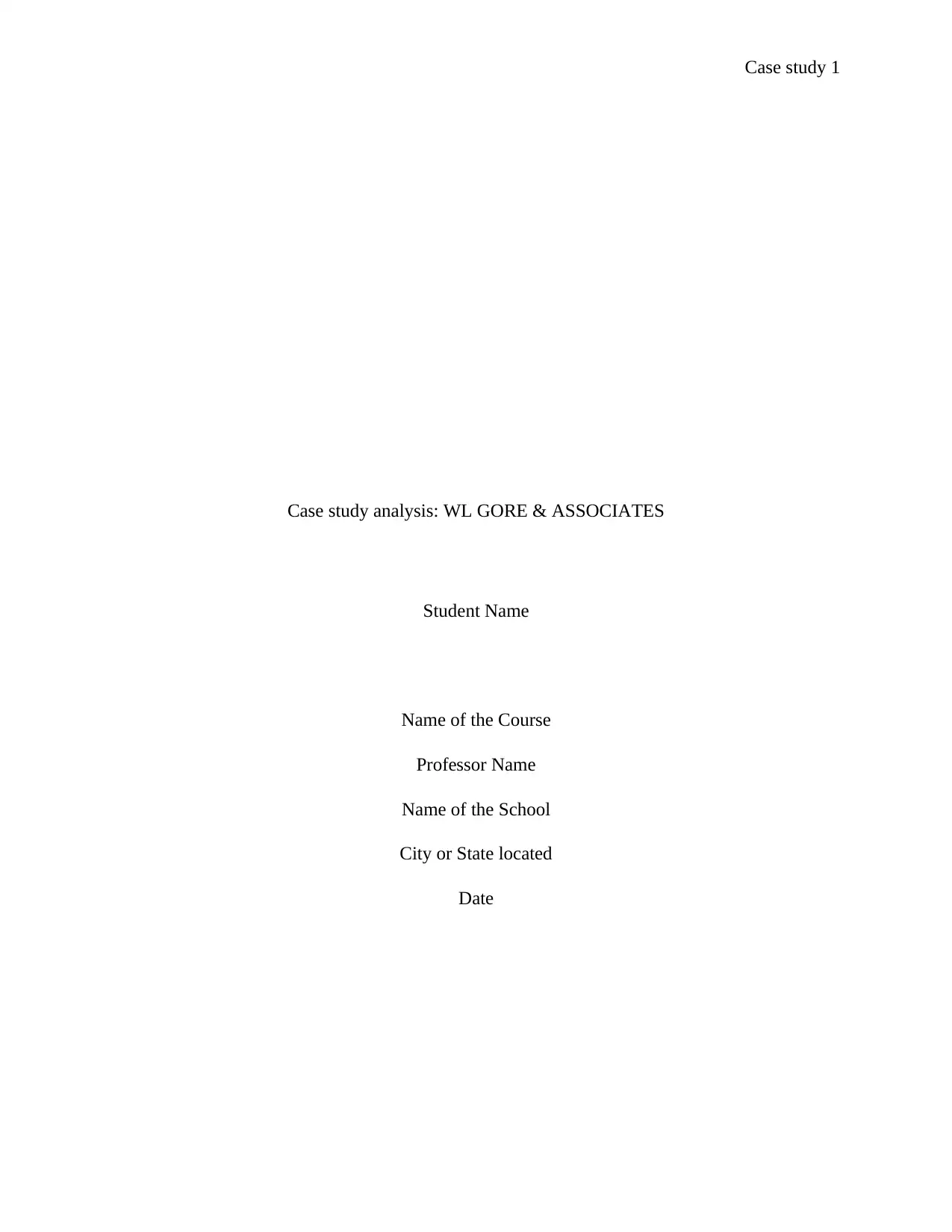
Case study 1
Case study analysis: WL GORE & ASSOCIATES
Student Name
Name of the Course
Professor Name
Name of the School
City or State located
Date
Case study analysis: WL GORE & ASSOCIATES
Student Name
Name of the Course
Professor Name
Name of the School
City or State located
Date
Paraphrase This Document
Need a fresh take? Get an instant paraphrase of this document with our AI Paraphraser
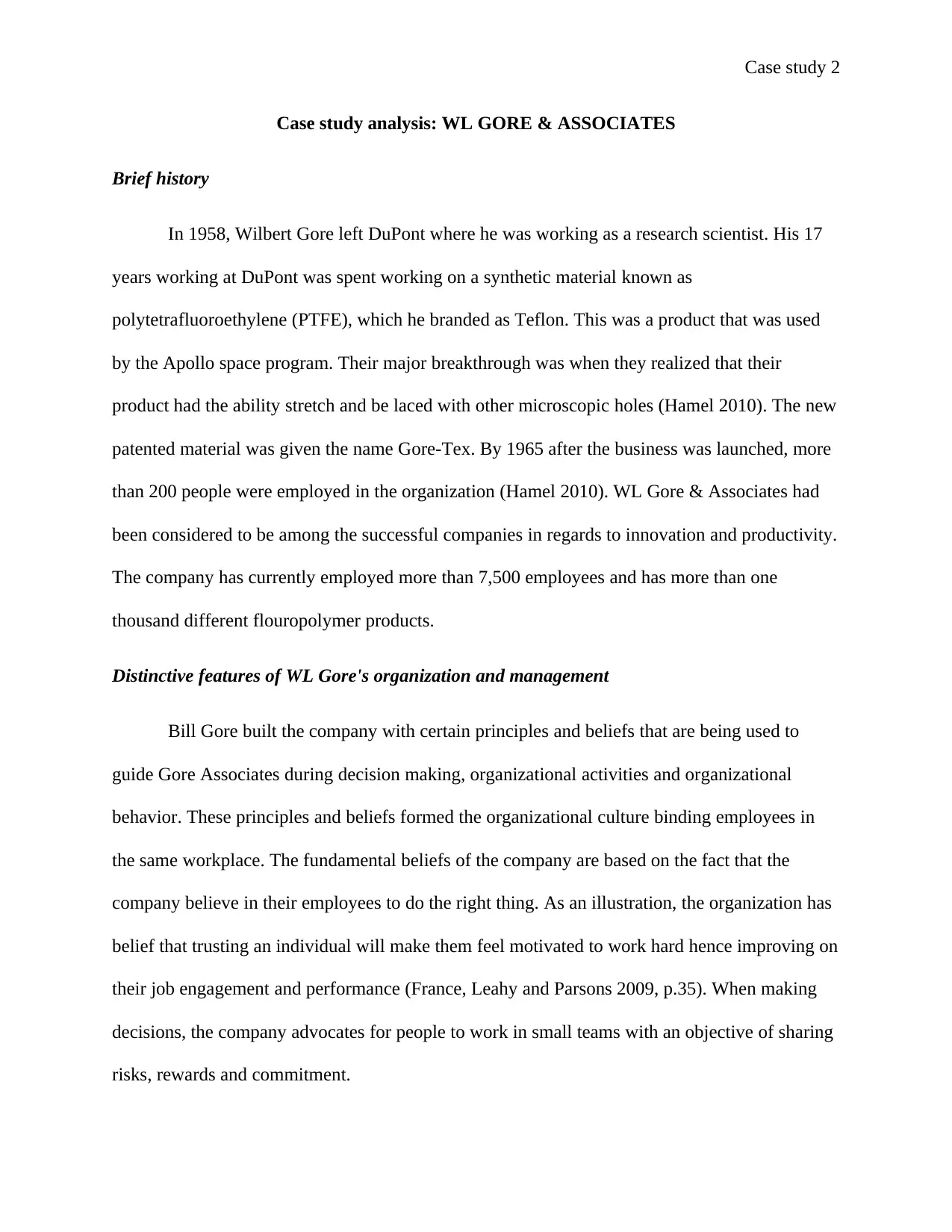
Case study 2
Case study analysis: WL GORE & ASSOCIATES
Brief history
In 1958, Wilbert Gore left DuPont where he was working as a research scientist. His 17
years working at DuPont was spent working on a synthetic material known as
polytetrafluoroethylene (PTFE), which he branded as Teflon. This was a product that was used
by the Apollo space program. Their major breakthrough was when they realized that their
product had the ability stretch and be laced with other microscopic holes (Hamel 2010). The new
patented material was given the name Gore-Tex. By 1965 after the business was launched, more
than 200 people were employed in the organization (Hamel 2010). WL Gore & Associates had
been considered to be among the successful companies in regards to innovation and productivity.
The company has currently employed more than 7,500 employees and has more than one
thousand different flouropolymer products.
Distinctive features of WL Gore's organization and management
Bill Gore built the company with certain principles and beliefs that are being used to
guide Gore Associates during decision making, organizational activities and organizational
behavior. These principles and beliefs formed the organizational culture binding employees in
the same workplace. The fundamental beliefs of the company are based on the fact that the
company believe in their employees to do the right thing. As an illustration, the organization has
belief that trusting an individual will make them feel motivated to work hard hence improving on
their job engagement and performance (France, Leahy and Parsons 2009, p.35). When making
decisions, the company advocates for people to work in small teams with an objective of sharing
risks, rewards and commitment.
Case study analysis: WL GORE & ASSOCIATES
Brief history
In 1958, Wilbert Gore left DuPont where he was working as a research scientist. His 17
years working at DuPont was spent working on a synthetic material known as
polytetrafluoroethylene (PTFE), which he branded as Teflon. This was a product that was used
by the Apollo space program. Their major breakthrough was when they realized that their
product had the ability stretch and be laced with other microscopic holes (Hamel 2010). The new
patented material was given the name Gore-Tex. By 1965 after the business was launched, more
than 200 people were employed in the organization (Hamel 2010). WL Gore & Associates had
been considered to be among the successful companies in regards to innovation and productivity.
The company has currently employed more than 7,500 employees and has more than one
thousand different flouropolymer products.
Distinctive features of WL Gore's organization and management
Bill Gore built the company with certain principles and beliefs that are being used to
guide Gore Associates during decision making, organizational activities and organizational
behavior. These principles and beliefs formed the organizational culture binding employees in
the same workplace. The fundamental beliefs of the company are based on the fact that the
company believe in their employees to do the right thing. As an illustration, the organization has
belief that trusting an individual will make them feel motivated to work hard hence improving on
their job engagement and performance (France, Leahy and Parsons 2009, p.35). When making
decisions, the company advocates for people to work in small teams with an objective of sharing
risks, rewards and commitment.
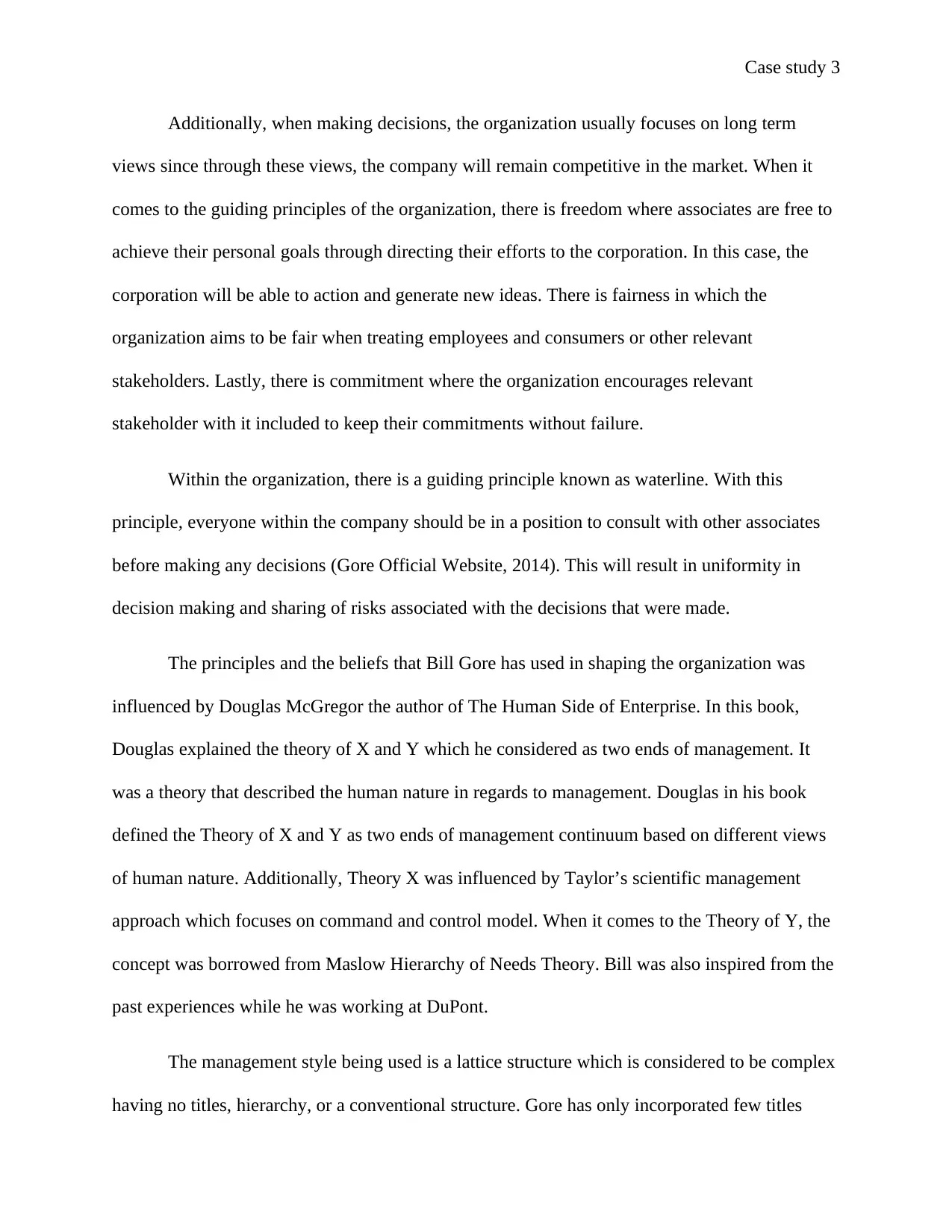
Case study 3
Additionally, when making decisions, the organization usually focuses on long term
views since through these views, the company will remain competitive in the market. When it
comes to the guiding principles of the organization, there is freedom where associates are free to
achieve their personal goals through directing their efforts to the corporation. In this case, the
corporation will be able to action and generate new ideas. There is fairness in which the
organization aims to be fair when treating employees and consumers or other relevant
stakeholders. Lastly, there is commitment where the organization encourages relevant
stakeholder with it included to keep their commitments without failure.
Within the organization, there is a guiding principle known as waterline. With this
principle, everyone within the company should be in a position to consult with other associates
before making any decisions (Gore Official Website, 2014). This will result in uniformity in
decision making and sharing of risks associated with the decisions that were made.
The principles and the beliefs that Bill Gore has used in shaping the organization was
influenced by Douglas McGregor the author of The Human Side of Enterprise. In this book,
Douglas explained the theory of X and Y which he considered as two ends of management. It
was a theory that described the human nature in regards to management. Douglas in his book
defined the Theory of X and Y as two ends of management continuum based on different views
of human nature. Additionally, Theory X was influenced by Taylor’s scientific management
approach which focuses on command and control model. When it comes to the Theory of Y, the
concept was borrowed from Maslow Hierarchy of Needs Theory. Bill was also inspired from the
past experiences while he was working at DuPont.
The management style being used is a lattice structure which is considered to be complex
having no titles, hierarchy, or a conventional structure. Gore has only incorporated few titles
Additionally, when making decisions, the organization usually focuses on long term
views since through these views, the company will remain competitive in the market. When it
comes to the guiding principles of the organization, there is freedom where associates are free to
achieve their personal goals through directing their efforts to the corporation. In this case, the
corporation will be able to action and generate new ideas. There is fairness in which the
organization aims to be fair when treating employees and consumers or other relevant
stakeholders. Lastly, there is commitment where the organization encourages relevant
stakeholder with it included to keep their commitments without failure.
Within the organization, there is a guiding principle known as waterline. With this
principle, everyone within the company should be in a position to consult with other associates
before making any decisions (Gore Official Website, 2014). This will result in uniformity in
decision making and sharing of risks associated with the decisions that were made.
The principles and the beliefs that Bill Gore has used in shaping the organization was
influenced by Douglas McGregor the author of The Human Side of Enterprise. In this book,
Douglas explained the theory of X and Y which he considered as two ends of management. It
was a theory that described the human nature in regards to management. Douglas in his book
defined the Theory of X and Y as two ends of management continuum based on different views
of human nature. Additionally, Theory X was influenced by Taylor’s scientific management
approach which focuses on command and control model. When it comes to the Theory of Y, the
concept was borrowed from Maslow Hierarchy of Needs Theory. Bill was also inspired from the
past experiences while he was working at DuPont.
The management style being used is a lattice structure which is considered to be complex
having no titles, hierarchy, or a conventional structure. Gore has only incorporated few titles
⊘ This is a preview!⊘
Do you want full access?
Subscribe today to unlock all pages.

Trusted by 1+ million students worldwide
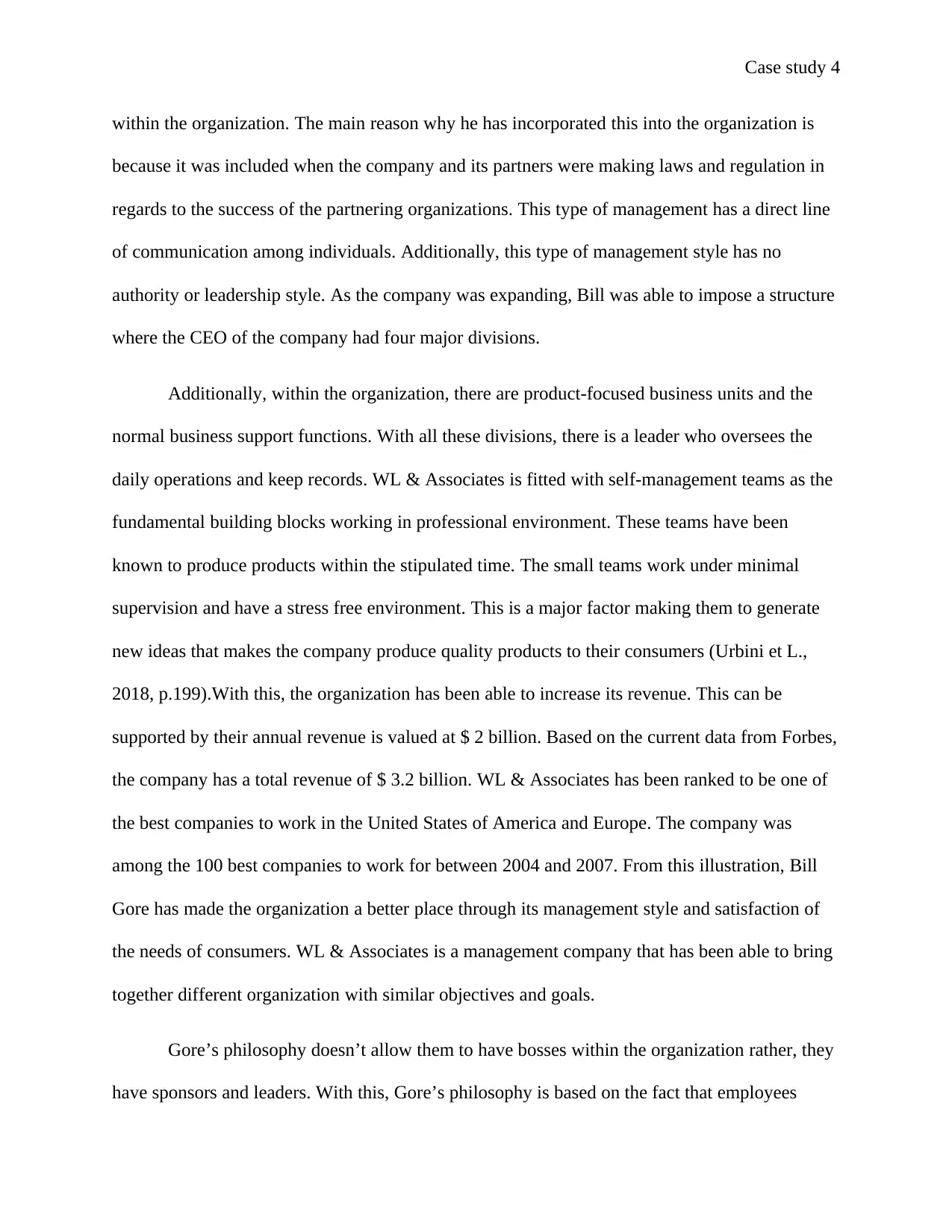
Case study 4
within the organization. The main reason why he has incorporated this into the organization is
because it was included when the company and its partners were making laws and regulation in
regards to the success of the partnering organizations. This type of management has a direct line
of communication among individuals. Additionally, this type of management style has no
authority or leadership style. As the company was expanding, Bill was able to impose a structure
where the CEO of the company had four major divisions.
Additionally, within the organization, there are product-focused business units and the
normal business support functions. With all these divisions, there is a leader who oversees the
daily operations and keep records. WL & Associates is fitted with self-management teams as the
fundamental building blocks working in professional environment. These teams have been
known to produce products within the stipulated time. The small teams work under minimal
supervision and have a stress free environment. This is a major factor making them to generate
new ideas that makes the company produce quality products to their consumers (Urbini et L.,
2018, p.199).With this, the organization has been able to increase its revenue. This can be
supported by their annual revenue is valued at $ 2 billion. Based on the current data from Forbes,
the company has a total revenue of $ 3.2 billion. WL & Associates has been ranked to be one of
the best companies to work in the United States of America and Europe. The company was
among the 100 best companies to work for between 2004 and 2007. From this illustration, Bill
Gore has made the organization a better place through its management style and satisfaction of
the needs of consumers. WL & Associates is a management company that has been able to bring
together different organization with similar objectives and goals.
Gore’s philosophy doesn’t allow them to have bosses within the organization rather, they
have sponsors and leaders. With this, Gore’s philosophy is based on the fact that employees
within the organization. The main reason why he has incorporated this into the organization is
because it was included when the company and its partners were making laws and regulation in
regards to the success of the partnering organizations. This type of management has a direct line
of communication among individuals. Additionally, this type of management style has no
authority or leadership style. As the company was expanding, Bill was able to impose a structure
where the CEO of the company had four major divisions.
Additionally, within the organization, there are product-focused business units and the
normal business support functions. With all these divisions, there is a leader who oversees the
daily operations and keep records. WL & Associates is fitted with self-management teams as the
fundamental building blocks working in professional environment. These teams have been
known to produce products within the stipulated time. The small teams work under minimal
supervision and have a stress free environment. This is a major factor making them to generate
new ideas that makes the company produce quality products to their consumers (Urbini et L.,
2018, p.199).With this, the organization has been able to increase its revenue. This can be
supported by their annual revenue is valued at $ 2 billion. Based on the current data from Forbes,
the company has a total revenue of $ 3.2 billion. WL & Associates has been ranked to be one of
the best companies to work in the United States of America and Europe. The company was
among the 100 best companies to work for between 2004 and 2007. From this illustration, Bill
Gore has made the organization a better place through its management style and satisfaction of
the needs of consumers. WL & Associates is a management company that has been able to bring
together different organization with similar objectives and goals.
Gore’s philosophy doesn’t allow them to have bosses within the organization rather, they
have sponsors and leaders. With this, Gore’s philosophy is based on the fact that employees
Paraphrase This Document
Need a fresh take? Get an instant paraphrase of this document with our AI Paraphraser

Case study 5
require no constant supervision. This means that, employees are trusted to complete their work
before the due date and deliver quality work. In the company, new associates joining the
company are always assigned a sponsor/leader to help them fit within the organization through
learning more about organizational structure, management style, and organizational practice
among other relevant aspects regarding the company (Manz and Pearce 2017). This kind of
familiarization makes it easier for new associates to fit within the company and not feel left out.
Additionally, Gore believes that when it comes to leadership, people should earn the
position. Therefore, the organization embraces the aspect of natural leadership. As an illustration,
leaders who are appointed in this organization, usually are based on merits. This can be
supported by the fact that there is a record being made on all employees where leadership skills
will be identified (Gilbreath and Karimi 2012, p.120). As a result, people who have been
identified to have effective leadership qualities are given the mantle of being a leader. For
example, identified leaders can be allowed to call for meetings. When people show up, the
person can be considered as an influential leader. Consequently, when people doesn’t show up,
the person will be considered as not able to lead.
In the company, W.L. & Associates, there are no mission and vision statement. As a
result, it has developed a culture that encourages associates to develop the statements depending
on their feelings and motivation. This means that, associates have the ability to develop their
own mission and vision statement with an objective of influencing the performance of the
organization. This type of strategy makes the associates feel like they are part of the organization
being that their thought and perception are recognized (Gannon Glover and Abel 2004, p.1170).
This is a motivation factor that makes other associates to do their best towards the success of the
require no constant supervision. This means that, employees are trusted to complete their work
before the due date and deliver quality work. In the company, new associates joining the
company are always assigned a sponsor/leader to help them fit within the organization through
learning more about organizational structure, management style, and organizational practice
among other relevant aspects regarding the company (Manz and Pearce 2017). This kind of
familiarization makes it easier for new associates to fit within the company and not feel left out.
Additionally, Gore believes that when it comes to leadership, people should earn the
position. Therefore, the organization embraces the aspect of natural leadership. As an illustration,
leaders who are appointed in this organization, usually are based on merits. This can be
supported by the fact that there is a record being made on all employees where leadership skills
will be identified (Gilbreath and Karimi 2012, p.120). As a result, people who have been
identified to have effective leadership qualities are given the mantle of being a leader. For
example, identified leaders can be allowed to call for meetings. When people show up, the
person can be considered as an influential leader. Consequently, when people doesn’t show up,
the person will be considered as not able to lead.
In the company, W.L. & Associates, there are no mission and vision statement. As a
result, it has developed a culture that encourages associates to develop the statements depending
on their feelings and motivation. This means that, associates have the ability to develop their
own mission and vision statement with an objective of influencing the performance of the
organization. This type of strategy makes the associates feel like they are part of the organization
being that their thought and perception are recognized (Gannon Glover and Abel 2004, p.1170).
This is a motivation factor that makes other associates to do their best towards the success of the
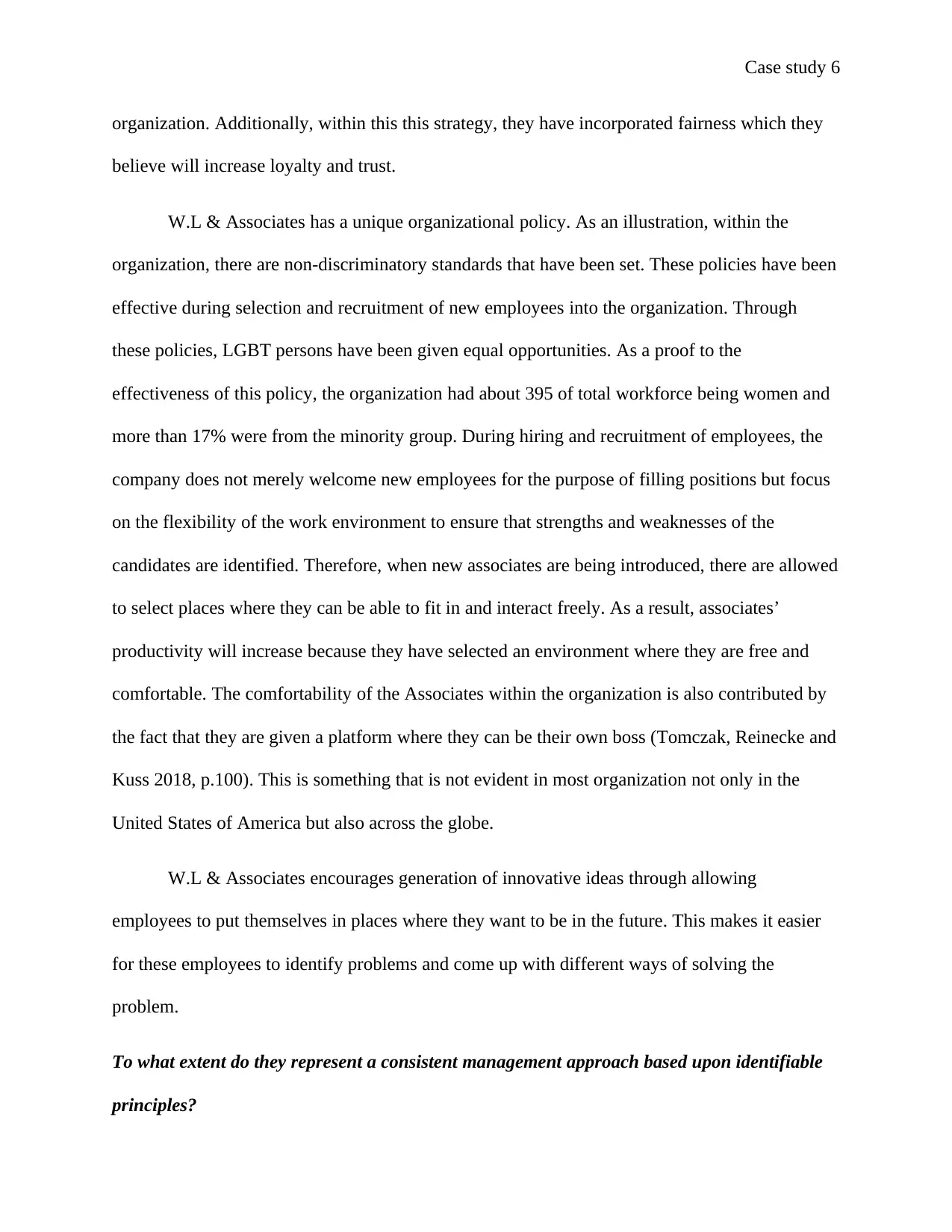
Case study 6
organization. Additionally, within this this strategy, they have incorporated fairness which they
believe will increase loyalty and trust.
W.L & Associates has a unique organizational policy. As an illustration, within the
organization, there are non-discriminatory standards that have been set. These policies have been
effective during selection and recruitment of new employees into the organization. Through
these policies, LGBT persons have been given equal opportunities. As a proof to the
effectiveness of this policy, the organization had about 395 of total workforce being women and
more than 17% were from the minority group. During hiring and recruitment of employees, the
company does not merely welcome new employees for the purpose of filling positions but focus
on the flexibility of the work environment to ensure that strengths and weaknesses of the
candidates are identified. Therefore, when new associates are being introduced, there are allowed
to select places where they can be able to fit in and interact freely. As a result, associates’
productivity will increase because they have selected an environment where they are free and
comfortable. The comfortability of the Associates within the organization is also contributed by
the fact that they are given a platform where they can be their own boss (Tomczak, Reinecke and
Kuss 2018, p.100). This is something that is not evident in most organization not only in the
United States of America but also across the globe.
W.L & Associates encourages generation of innovative ideas through allowing
employees to put themselves in places where they want to be in the future. This makes it easier
for these employees to identify problems and come up with different ways of solving the
problem.
To what extent do they represent a consistent management approach based upon identifiable
principles?
organization. Additionally, within this this strategy, they have incorporated fairness which they
believe will increase loyalty and trust.
W.L & Associates has a unique organizational policy. As an illustration, within the
organization, there are non-discriminatory standards that have been set. These policies have been
effective during selection and recruitment of new employees into the organization. Through
these policies, LGBT persons have been given equal opportunities. As a proof to the
effectiveness of this policy, the organization had about 395 of total workforce being women and
more than 17% were from the minority group. During hiring and recruitment of employees, the
company does not merely welcome new employees for the purpose of filling positions but focus
on the flexibility of the work environment to ensure that strengths and weaknesses of the
candidates are identified. Therefore, when new associates are being introduced, there are allowed
to select places where they can be able to fit in and interact freely. As a result, associates’
productivity will increase because they have selected an environment where they are free and
comfortable. The comfortability of the Associates within the organization is also contributed by
the fact that they are given a platform where they can be their own boss (Tomczak, Reinecke and
Kuss 2018, p.100). This is something that is not evident in most organization not only in the
United States of America but also across the globe.
W.L & Associates encourages generation of innovative ideas through allowing
employees to put themselves in places where they want to be in the future. This makes it easier
for these employees to identify problems and come up with different ways of solving the
problem.
To what extent do they represent a consistent management approach based upon identifiable
principles?
⊘ This is a preview!⊘
Do you want full access?
Subscribe today to unlock all pages.

Trusted by 1+ million students worldwide
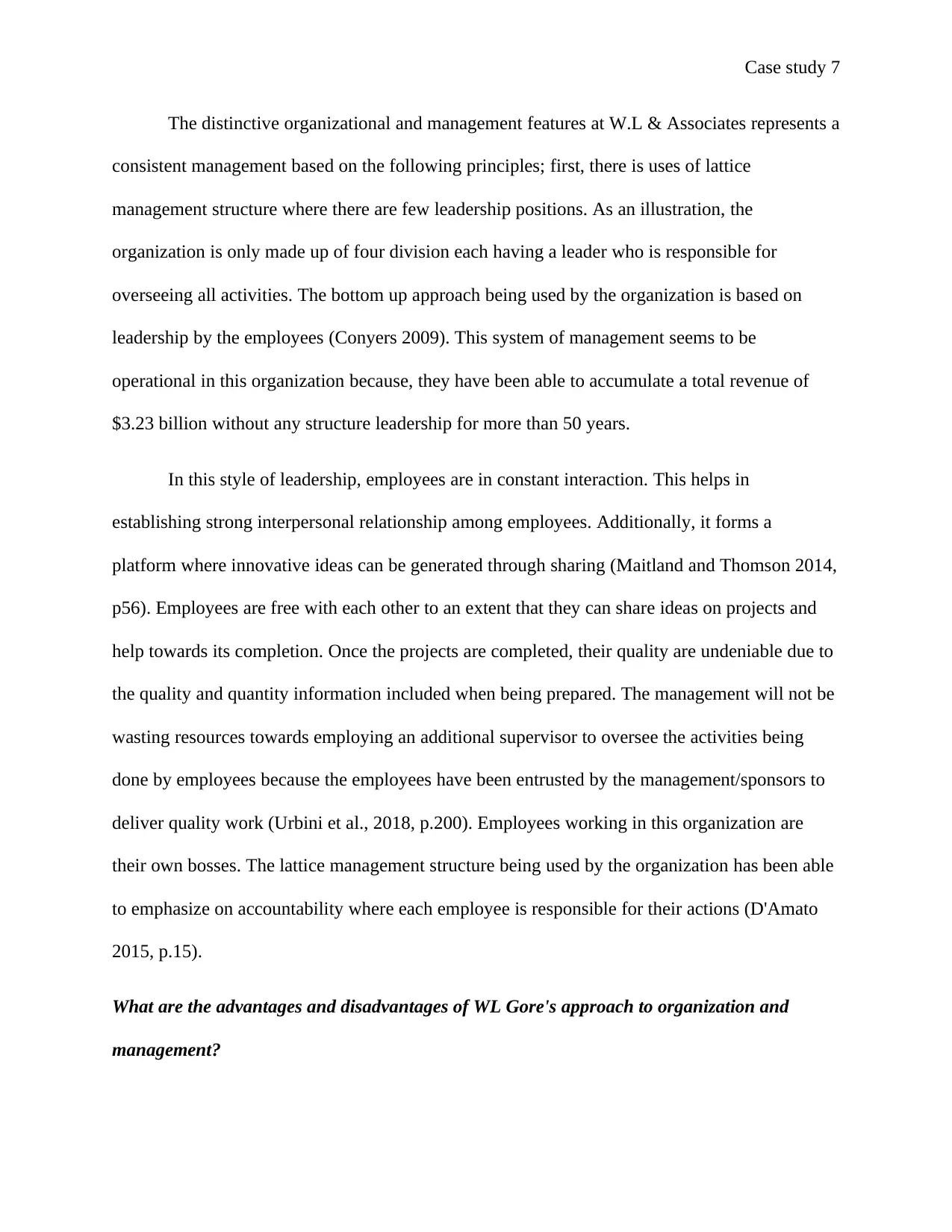
Case study 7
The distinctive organizational and management features at W.L & Associates represents a
consistent management based on the following principles; first, there is uses of lattice
management structure where there are few leadership positions. As an illustration, the
organization is only made up of four division each having a leader who is responsible for
overseeing all activities. The bottom up approach being used by the organization is based on
leadership by the employees (Conyers 2009). This system of management seems to be
operational in this organization because, they have been able to accumulate a total revenue of
$3.23 billion without any structure leadership for more than 50 years.
In this style of leadership, employees are in constant interaction. This helps in
establishing strong interpersonal relationship among employees. Additionally, it forms a
platform where innovative ideas can be generated through sharing (Maitland and Thomson 2014,
p56). Employees are free with each other to an extent that they can share ideas on projects and
help towards its completion. Once the projects are completed, their quality are undeniable due to
the quality and quantity information included when being prepared. The management will not be
wasting resources towards employing an additional supervisor to oversee the activities being
done by employees because the employees have been entrusted by the management/sponsors to
deliver quality work (Urbini et al., 2018, p.200). Employees working in this organization are
their own bosses. The lattice management structure being used by the organization has been able
to emphasize on accountability where each employee is responsible for their actions (D'Amato
2015, p.15).
What are the advantages and disadvantages of WL Gore's approach to organization and
management?
The distinctive organizational and management features at W.L & Associates represents a
consistent management based on the following principles; first, there is uses of lattice
management structure where there are few leadership positions. As an illustration, the
organization is only made up of four division each having a leader who is responsible for
overseeing all activities. The bottom up approach being used by the organization is based on
leadership by the employees (Conyers 2009). This system of management seems to be
operational in this organization because, they have been able to accumulate a total revenue of
$3.23 billion without any structure leadership for more than 50 years.
In this style of leadership, employees are in constant interaction. This helps in
establishing strong interpersonal relationship among employees. Additionally, it forms a
platform where innovative ideas can be generated through sharing (Maitland and Thomson 2014,
p56). Employees are free with each other to an extent that they can share ideas on projects and
help towards its completion. Once the projects are completed, their quality are undeniable due to
the quality and quantity information included when being prepared. The management will not be
wasting resources towards employing an additional supervisor to oversee the activities being
done by employees because the employees have been entrusted by the management/sponsors to
deliver quality work (Urbini et al., 2018, p.200). Employees working in this organization are
their own bosses. The lattice management structure being used by the organization has been able
to emphasize on accountability where each employee is responsible for their actions (D'Amato
2015, p.15).
What are the advantages and disadvantages of WL Gore's approach to organization and
management?
Paraphrase This Document
Need a fresh take? Get an instant paraphrase of this document with our AI Paraphraser

Case study 8
The organization uses lattice management structure. This is a system of management
where they are bosses or departmental heads controlling the organization and employees. This
means that, the organization hasn’t assigned any sense of authority figure within its operations
and management. In this type of management system associates become leaders once they join
the company. For Gore, they have been focusing on people who are naturally born leaders. This
increases productivity because they are able to select leaders with effective leadership qualities
(Lian and Tui, 2012, p.60). This is something that is difficult to find in most organization across
the globe.
Advantages
In a lattice organizational structure, there is advocacy of ideas. This means that, an
organization is in a position to generate numerous innovative ideas because employees are free to
speak their viewpoints during decision making (McDonagh et al., 2014, p.20). Within this
management, employees will be dedicated to give their best since they are their own bosses.
Secondly, employees are not entitled to any sense of authority but are given sponsors who will
ensure that they have a place within the company (Praszkier 2016, p.35). A lattice management
style leads to employees feeling like they are part of the organization. The absence of hierarchies
in the organization has been replaced by personal commitments. Employees are dedicated to
ensure that they act in accordance to their excitation in regards to enhancing the image of the
organization through respecting its values and goals. Thirdly, employees are free to communicate
to one another and share ideas without the interference from the sponsors (Mizuno et al., 2006,
p.169). The company believes that through sharing, there will be production of quality products.
When it comes to handling the operations of the company, decisions regarding the
success of the company should be consulted from other associates. This will prevent occurrence
The organization uses lattice management structure. This is a system of management
where they are bosses or departmental heads controlling the organization and employees. This
means that, the organization hasn’t assigned any sense of authority figure within its operations
and management. In this type of management system associates become leaders once they join
the company. For Gore, they have been focusing on people who are naturally born leaders. This
increases productivity because they are able to select leaders with effective leadership qualities
(Lian and Tui, 2012, p.60). This is something that is difficult to find in most organization across
the globe.
Advantages
In a lattice organizational structure, there is advocacy of ideas. This means that, an
organization is in a position to generate numerous innovative ideas because employees are free to
speak their viewpoints during decision making (McDonagh et al., 2014, p.20). Within this
management, employees will be dedicated to give their best since they are their own bosses.
Secondly, employees are not entitled to any sense of authority but are given sponsors who will
ensure that they have a place within the company (Praszkier 2016, p.35). A lattice management
style leads to employees feeling like they are part of the organization. The absence of hierarchies
in the organization has been replaced by personal commitments. Employees are dedicated to
ensure that they act in accordance to their excitation in regards to enhancing the image of the
organization through respecting its values and goals. Thirdly, employees are free to communicate
to one another and share ideas without the interference from the sponsors (Mizuno et al., 2006,
p.169). The company believes that through sharing, there will be production of quality products.
When it comes to handling the operations of the company, decisions regarding the
success of the company should be consulted from other associates. This will prevent occurrence
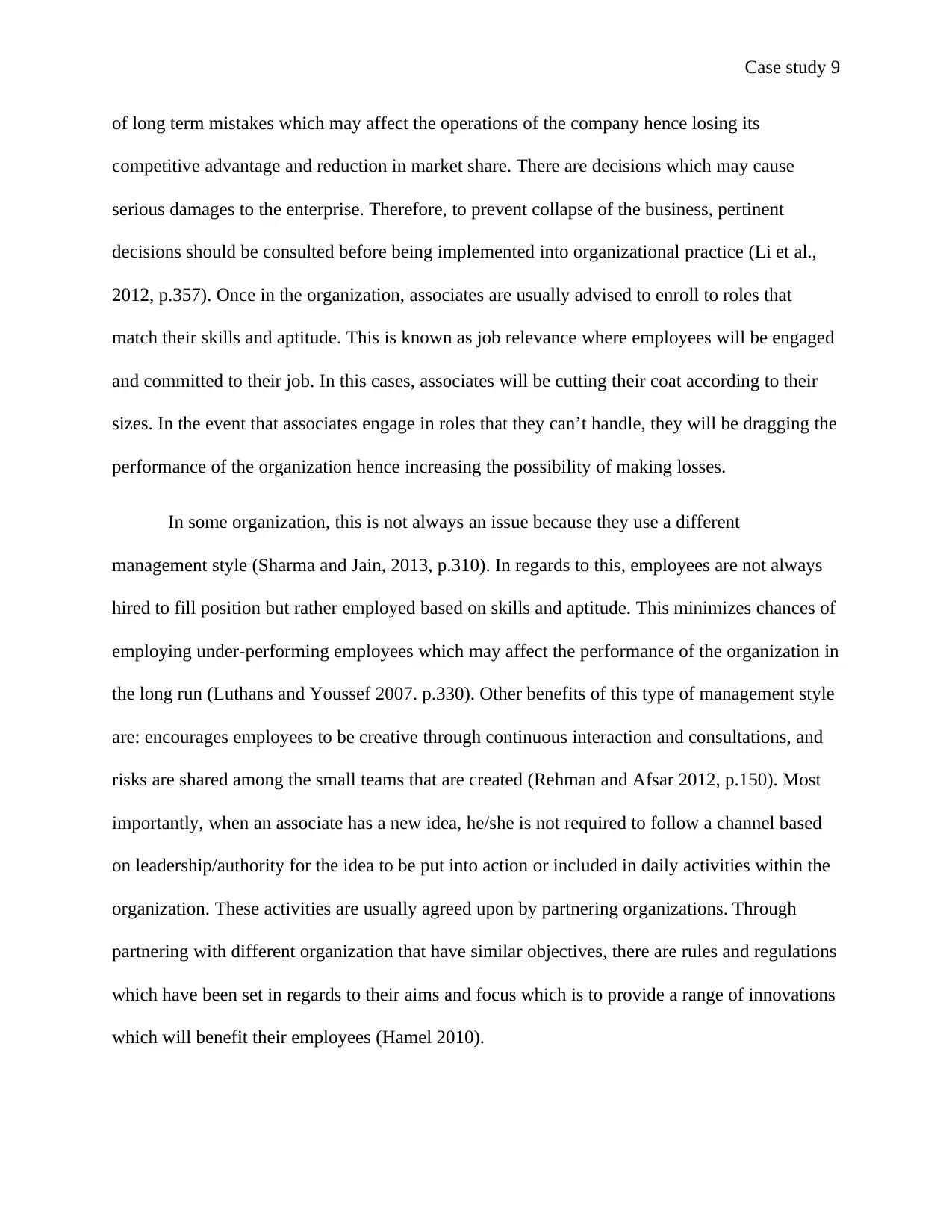
Case study 9
of long term mistakes which may affect the operations of the company hence losing its
competitive advantage and reduction in market share. There are decisions which may cause
serious damages to the enterprise. Therefore, to prevent collapse of the business, pertinent
decisions should be consulted before being implemented into organizational practice (Li et al.,
2012, p.357). Once in the organization, associates are usually advised to enroll to roles that
match their skills and aptitude. This is known as job relevance where employees will be engaged
and committed to their job. In this cases, associates will be cutting their coat according to their
sizes. In the event that associates engage in roles that they can’t handle, they will be dragging the
performance of the organization hence increasing the possibility of making losses.
In some organization, this is not always an issue because they use a different
management style (Sharma and Jain, 2013, p.310). In regards to this, employees are not always
hired to fill position but rather employed based on skills and aptitude. This minimizes chances of
employing under-performing employees which may affect the performance of the organization in
the long run (Luthans and Youssef 2007. p.330). Other benefits of this type of management style
are: encourages employees to be creative through continuous interaction and consultations, and
risks are shared among the small teams that are created (Rehman and Afsar 2012, p.150). Most
importantly, when an associate has a new idea, he/she is not required to follow a channel based
on leadership/authority for the idea to be put into action or included in daily activities within the
organization. These activities are usually agreed upon by partnering organizations. Through
partnering with different organization that have similar objectives, there are rules and regulations
which have been set in regards to their aims and focus which is to provide a range of innovations
which will benefit their employees (Hamel 2010).
of long term mistakes which may affect the operations of the company hence losing its
competitive advantage and reduction in market share. There are decisions which may cause
serious damages to the enterprise. Therefore, to prevent collapse of the business, pertinent
decisions should be consulted before being implemented into organizational practice (Li et al.,
2012, p.357). Once in the organization, associates are usually advised to enroll to roles that
match their skills and aptitude. This is known as job relevance where employees will be engaged
and committed to their job. In this cases, associates will be cutting their coat according to their
sizes. In the event that associates engage in roles that they can’t handle, they will be dragging the
performance of the organization hence increasing the possibility of making losses.
In some organization, this is not always an issue because they use a different
management style (Sharma and Jain, 2013, p.310). In regards to this, employees are not always
hired to fill position but rather employed based on skills and aptitude. This minimizes chances of
employing under-performing employees which may affect the performance of the organization in
the long run (Luthans and Youssef 2007. p.330). Other benefits of this type of management style
are: encourages employees to be creative through continuous interaction and consultations, and
risks are shared among the small teams that are created (Rehman and Afsar 2012, p.150). Most
importantly, when an associate has a new idea, he/she is not required to follow a channel based
on leadership/authority for the idea to be put into action or included in daily activities within the
organization. These activities are usually agreed upon by partnering organizations. Through
partnering with different organization that have similar objectives, there are rules and regulations
which have been set in regards to their aims and focus which is to provide a range of innovations
which will benefit their employees (Hamel 2010).
⊘ This is a preview!⊘
Do you want full access?
Subscribe today to unlock all pages.

Trusted by 1+ million students worldwide

Case study 10
Disadvantages
The disadvantages include: the recruitment and selection process of candidates are
practically non-existence. Secondly, the compensation and rewards of employees have no clear
defined procedure. This is because structures are not conducted on the basis of qualification and
expertise level (Cicero, Pierro, and van Knippenberg, 2010.p.415). This happens because
compensation and reward are meaningless in this type of management style. When it comes to
evaluation of performance, it is not being practiced in lattice management structure. This limits
the opportunities for development among employees. This is because the lattice management
system doesn’t have clearly established performance standards to be used towards improving
employee development (Morris, 2009).
To what extent is the WL Gore approach to organization and management transferable to
other companies? And if it is, to what types of companies?
Aspects in the Gore’s approach that are transferable to other companies include: the
guiding principles such as freedom, waterlines, commitment and fairness. Additionally, due to
the type of management that the organization is using which has no hierarchies, employees are
able to work in small team where there will be increased understanding and minimal conflicts
(Hill et al., 2014). With this type of management structure, there will be increased generation of
new and innovative ideas. This creates a platform where an organization can easily penetrate the
market once the new product has been developed. Furthermore, a lattice management style leads
to employees feeling like they are part of the organization. The absence of hierarchies in the
organization has been replaced by personal commitments. Additionally, there is peer driven
judgment where there will be increased establishment of strong interpersonal relationship and
positive working environment.
Disadvantages
The disadvantages include: the recruitment and selection process of candidates are
practically non-existence. Secondly, the compensation and rewards of employees have no clear
defined procedure. This is because structures are not conducted on the basis of qualification and
expertise level (Cicero, Pierro, and van Knippenberg, 2010.p.415). This happens because
compensation and reward are meaningless in this type of management style. When it comes to
evaluation of performance, it is not being practiced in lattice management structure. This limits
the opportunities for development among employees. This is because the lattice management
system doesn’t have clearly established performance standards to be used towards improving
employee development (Morris, 2009).
To what extent is the WL Gore approach to organization and management transferable to
other companies? And if it is, to what types of companies?
Aspects in the Gore’s approach that are transferable to other companies include: the
guiding principles such as freedom, waterlines, commitment and fairness. Additionally, due to
the type of management that the organization is using which has no hierarchies, employees are
able to work in small team where there will be increased understanding and minimal conflicts
(Hill et al., 2014). With this type of management structure, there will be increased generation of
new and innovative ideas. This creates a platform where an organization can easily penetrate the
market once the new product has been developed. Furthermore, a lattice management style leads
to employees feeling like they are part of the organization. The absence of hierarchies in the
organization has been replaced by personal commitments. Additionally, there is peer driven
judgment where there will be increased establishment of strong interpersonal relationship and
positive working environment.
Paraphrase This Document
Need a fresh take? Get an instant paraphrase of this document with our AI Paraphraser

Case study 11
The companies that these aspects can be transferred to include:
Engineering firms: in these firms, the management should employee people with skills
that will help the organization achieve its goals. The skills should be relevant in regards
to the type of engineering firm. Additionally, with few leadership positions and
employees working in small teams, it will be easy to complete tasks/projects faster.
Medical field companies; in medical field companies, organizations should be in a
position to partner with firms with similar objectives. This will help in market penetration
and increasing the number of their sales.
Designer teams; in this type of organization, lattice system of management can be used to
generate new designer garments through treating each employees’ contributing as
significant.
Technology firms: When it comes to technology firms, lattice system of management can
be used to give each employee freedom to generate ideas without interference.
Additionally, employees can work in small teams to ensure that allocated projects are
completed. Most importantly, through effective teamwork, it will be easier to generate
new and innovative ideas.
The companies that these aspects can be transferred to include:
Engineering firms: in these firms, the management should employee people with skills
that will help the organization achieve its goals. The skills should be relevant in regards
to the type of engineering firm. Additionally, with few leadership positions and
employees working in small teams, it will be easy to complete tasks/projects faster.
Medical field companies; in medical field companies, organizations should be in a
position to partner with firms with similar objectives. This will help in market penetration
and increasing the number of their sales.
Designer teams; in this type of organization, lattice system of management can be used to
generate new designer garments through treating each employees’ contributing as
significant.
Technology firms: When it comes to technology firms, lattice system of management can
be used to give each employee freedom to generate ideas without interference.
Additionally, employees can work in small teams to ensure that allocated projects are
completed. Most importantly, through effective teamwork, it will be easier to generate
new and innovative ideas.
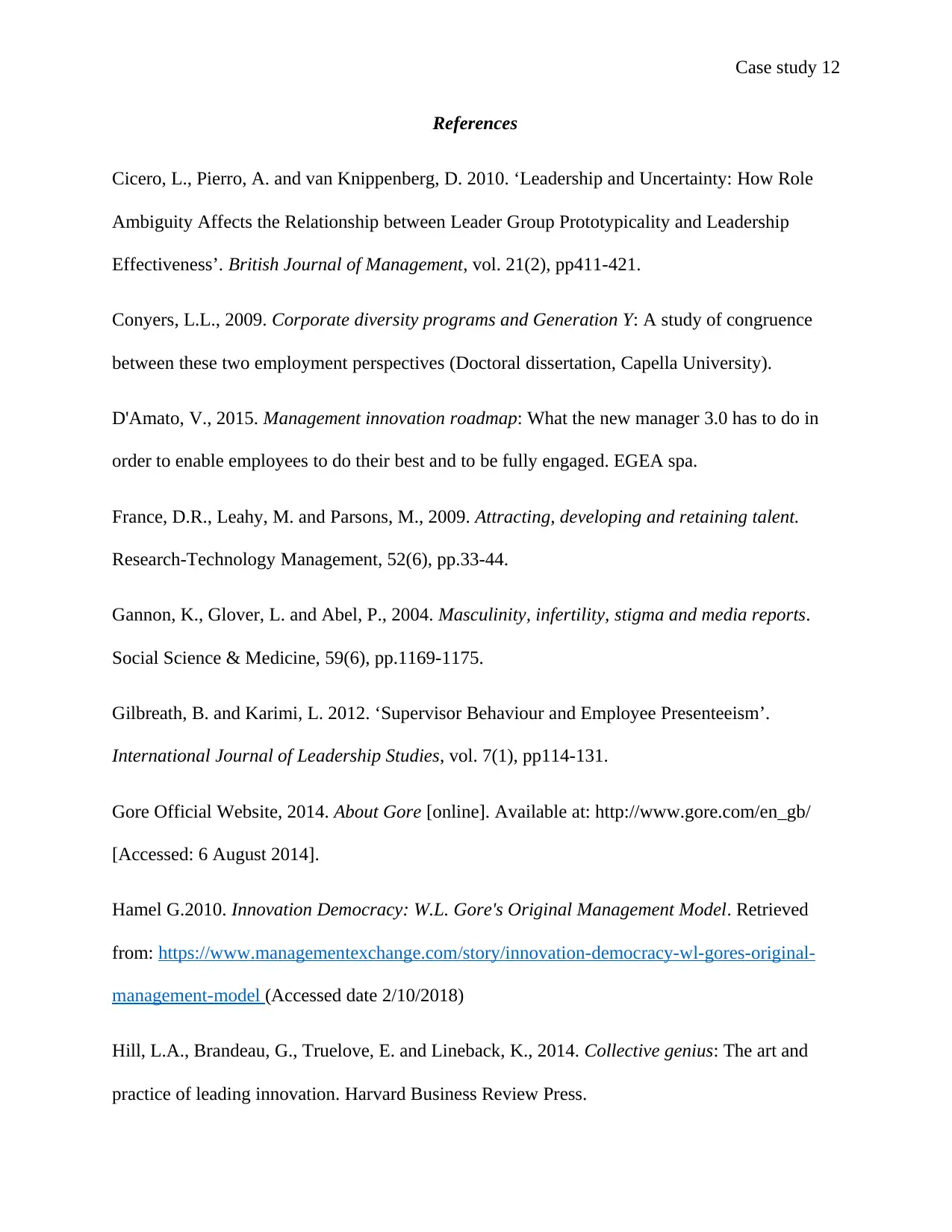
Case study 12
References
Cicero, L., Pierro, A. and van Knippenberg, D. 2010. ‘Leadership and Uncertainty: How Role
Ambiguity Affects the Relationship between Leader Group Prototypicality and Leadership
Effectiveness’. British Journal of Management, vol. 21(2), pp411-421.
Conyers, L.L., 2009. Corporate diversity programs and Generation Y: A study of congruence
between these two employment perspectives (Doctoral dissertation, Capella University).
D'Amato, V., 2015. Management innovation roadmap: What the new manager 3.0 has to do in
order to enable employees to do their best and to be fully engaged. EGEA spa.
France, D.R., Leahy, M. and Parsons, M., 2009. Attracting, developing and retaining talent.
Research-Technology Management, 52(6), pp.33-44.
Gannon, K., Glover, L. and Abel, P., 2004. Masculinity, infertility, stigma and media reports.
Social Science & Medicine, 59(6), pp.1169-1175.
Gilbreath, B. and Karimi, L. 2012. ‘Supervisor Behaviour and Employee Presenteeism’.
International Journal of Leadership Studies, vol. 7(1), pp114-131.
Gore Official Website, 2014. About Gore [online]. Available at: http://www.gore.com/en_gb/
[Accessed: 6 August 2014].
Hamel G.2010. Innovation Democracy: W.L. Gore's Original Management Model. Retrieved
from: https://www.managementexchange.com/story/innovation-democracy-wl-gores-original-
management-model (Accessed date 2/10/2018)
Hill, L.A., Brandeau, G., Truelove, E. and Lineback, K., 2014. Collective genius: The art and
practice of leading innovation. Harvard Business Review Press.
References
Cicero, L., Pierro, A. and van Knippenberg, D. 2010. ‘Leadership and Uncertainty: How Role
Ambiguity Affects the Relationship between Leader Group Prototypicality and Leadership
Effectiveness’. British Journal of Management, vol. 21(2), pp411-421.
Conyers, L.L., 2009. Corporate diversity programs and Generation Y: A study of congruence
between these two employment perspectives (Doctoral dissertation, Capella University).
D'Amato, V., 2015. Management innovation roadmap: What the new manager 3.0 has to do in
order to enable employees to do their best and to be fully engaged. EGEA spa.
France, D.R., Leahy, M. and Parsons, M., 2009. Attracting, developing and retaining talent.
Research-Technology Management, 52(6), pp.33-44.
Gannon, K., Glover, L. and Abel, P., 2004. Masculinity, infertility, stigma and media reports.
Social Science & Medicine, 59(6), pp.1169-1175.
Gilbreath, B. and Karimi, L. 2012. ‘Supervisor Behaviour and Employee Presenteeism’.
International Journal of Leadership Studies, vol. 7(1), pp114-131.
Gore Official Website, 2014. About Gore [online]. Available at: http://www.gore.com/en_gb/
[Accessed: 6 August 2014].
Hamel G.2010. Innovation Democracy: W.L. Gore's Original Management Model. Retrieved
from: https://www.managementexchange.com/story/innovation-democracy-wl-gores-original-
management-model (Accessed date 2/10/2018)
Hill, L.A., Brandeau, G., Truelove, E. and Lineback, K., 2014. Collective genius: The art and
practice of leading innovation. Harvard Business Review Press.
⊘ This is a preview!⊘
Do you want full access?
Subscribe today to unlock all pages.

Trusted by 1+ million students worldwide
1 out of 14
Related Documents
Your All-in-One AI-Powered Toolkit for Academic Success.
+13062052269
info@desklib.com
Available 24*7 on WhatsApp / Email
![[object Object]](/_next/static/media/star-bottom.7253800d.svg)
Unlock your academic potential
Copyright © 2020–2025 A2Z Services. All Rights Reserved. Developed and managed by ZUCOL.




